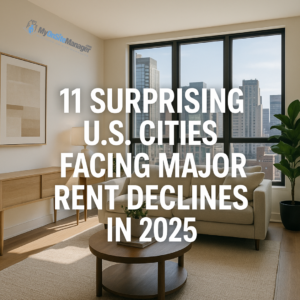As rental prices soar across much of the country, a surprising trend is emerging in several key U.S. cities, rents are not just stalling they’re collapsing.
For years, tenants have braced themselves against relentless rent hikes fueled by housing shortages, remote work migrations, and post-pandemic inflation. But now, data is signaling a shift one that could provide much-needed relief in pockets of the country.
In this post, we highlight the cities leading the rent reversal and explore the forces behind this unexpected transformation in the rental market.
National Rent Trends: A Market Correction in Motion
As of mid-2025, median asking rent across the U.S. has fallen to $1,633, down 1% year-over-year, according to rental data firms like Zumper and Realtor.com. That marks the largest annual decline since August 2020, and a significant drop from the record high of $1,705 set in August 2022.
Even more notable is the breakdown by apartment size:
-
Two-bedroom rents: down 1.8%
-
One-bedroom rents: down 0.7%
-
Three-bedroom or larger units: down 0.2%
These changes aren’t universal, but they’re particularly sharp in 11 cities that are seeing rent corrections far beyond the national average.
The 11 Cities Where Rents Are Collapsing
The list includes some well-known housing hotspots that saw massive growth during the pandemic. Now, the tide is turning. Here’s a look at the cities experiencing the steepest rent drops:
-
Austin, TX – -8.8%
Once a magnet for tech talent and remote workers, Austin is seeing a market correction thanks to oversupply in new developments. -
Minneapolis, MN – -6.3%
Despite strong demand in past years, population shifts and a cooling job market are contributing to lower prices. -
Columbus, OH – -3.5%
Slowing migration patterns and an increase in available rentals are relieving upward pressure on rents. -
Nashville, TN – -3.4%
Rapid construction during its housing boom has outpaced tenant demand in certain neighborhoods. -
Portland, OR – -3.4%
With affordability concerns and population stagnation, the city is seeing an exodus from urban cores. -
Atlanta, GA
-
San Antonio, TX
-
Charlotte, NC
-
Phoenix, AZ
-
Las Vegas, NV
-
Salt Lake City, UT
Note: Exact percentage drops for cities 6–11 are less pronounced but still notable compared to previous years.
What’s Causing the Rent Collapse?
Several key factors are converging to drive this trend:
1. Oversupply of New Units
In cities like Austin, Phoenix, and Charlotte, developers ramped up construction to meet pandemic-era demand. Now, those units are flooding the market outpacing population growth and pushing landlords to lower prices to stay competitive.
2. Remote Work Reversals
Many companies are calling employees back to the office, reducing demand in “Zoomtowns” that once flourished under remote work trends. This has reduced pressure on once-booming rental markets.
3. Population Shifts
Migration is slowing, especially among high-income renters. As people move away from high-cost metros or delay household formation due to inflation, vacancies rise and rents drop.
4. Seasonal Slowdown
While rental demand typically peaks in spring and summer, 2025 has seen a sharper-than-usual drop in mid-year leasing activity likely influenced by economic uncertainty.
5. Affordability Pushback
Tenants have reached a ceiling on what they can pay. With rent-to-income ratios already stretched thin in many cities, landlords are being forced to adjust expectations.
What This Means for Renters
This trend opens new doors for renters literally and figuratively.
-
Negotiation Power: In softening markets, renters may be able to secure lower rent, move-in incentives, or flexible lease terms.
-
More Choices: With increased supply, renters can be more selective choosing better amenities, neighborhoods, or newer units.
-
Mobility Opportunity: Relocating to a city experiencing a rent dip could lead to significant monthly savings, especially for remote workers or digital nomads.
Implications for Landlords and Investors
Landlords in these cooling markets are facing new challenges:
-
Increased Vacancy Risk: Units may sit empty longer, especially in oversaturated buildings.
-
Price Compression: Rent rolls may need to be adjusted downward to attract tenants, reducing overall ROI.
-
Pressure to Upgrade: Tenants now have more leverage to demand better property conditions, upgrades, or added services.
Savvy landlords may shift focus to tenant retention strategies, diversified portfolios, or repositioning older assets.
Conclusion: A Cooling Market That Still Holds Heat
While the rental market is shifting, it’s far from a crash. What we’re seeing is more of a balancing act with corrections where overbuilding met overconfidence. These rent declines offer a breather for tenants and a reality check for investors.
If you’re living in or considering a move to one of these 11 cities, now might be the ideal moment to reassess your housing options.
Source: The next 11 cities to see a rent collapse might surprise you (MSN)

